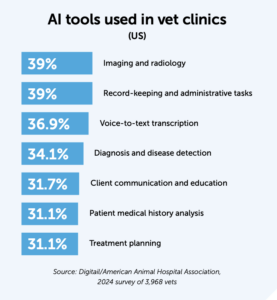Making veterinary care more accessible

There’s a lot going on in the veterinary sector and key concepts are more convenience, less stress, time-saving strategies, cost-effectiveness and new technology.
In different parts of the world, both the private and public sectors are working to make veterinary care more easily available for all pet parents. A combination of new laws and new technology, including artificial intelligence (AI), is at the heart of many new veterinary services: mobile vets bringing pet healthcare to people’s homes; online consultations that save time for provider and consumer; and opportunities for other veterinary clinic staff to provide pet care to help counter vet shortages.
The mobile vet model
UK-based WW Mobile Veterinary Services has strategically adopted a mobile model to offer cost- competitive consultations, tests, medicines and surgery, gaining a competitive edge by eliminating corporate and high staff overheads. The company operates within a 40-mile radius of the port city of Southampton.
Boston-based start-up BetterVet has entered into a partnership with pet healthcare membership provider United Pet Care to provide mobile veterinary care services for employees through company packages in the US.
Mobile services are also becoming popular in the Middle East. Modern Vet, a veterinary hospital in the United Arab Emirates, is collaborating with Lebanon-based Vetlivery to launch its first mobile clinic, recognizing the escalating demand for convenient pet healthcare solutions. “Pet owners seek hassle-free options that cater to their busy lifestyles and prioritize their pet’s well-being. This rising demand is fueled by a growing awareness of pet health and wellness,” says Maria Al Mouallem, founder of Vetlivery.
Non-profit care
Non-profit organization the Banfield Foundation last year unveiled plans to donate 6 mobile veterinary units across the US. Concurrently, Sacramento County launched a pioneering mobile service called PAWS Clinic at the end of 2023. This is specifically designed for pets of unhoused residents. “Our mobile veterinary clinic removes the barriers of cost and transportation. We can meet people where they are and provide free spay/neuter and wellness services,” says Luna Anona, Public Information Officer for Sacramento County Animal Care Services.
Addressing vet shortages
The shortage of veterinarians makes recruitment of licensed professionals complicated and this hinders the widespread practice of mobile delivery.
Traditional bricks-and-mortar practices often don’t actively promote mobile services due to constraints on client volume, according to Mark Cushing, co-founder of the Veterinary Virtual Care Association (VVCA). Talking about his expectations for this year, he says: “Mobile care is expected to grow due to its convenience factor for pet owners, especially if the mobile veterinary provider offers – or is linked to – a telemedicine service.”
States legislate for telemedicine
A new law to redefine the veterinarian-client-patient relationship (VCPR) entered into force in California in January. This regulation allows pet parents to access diagnoses and prescriptions for their pets through video consultations. Arizona also approved a veterinary telemedicine law last year, allowing pet owners to access telemedicine services after licensed veterinarians have established a VCPR.
The regulatory shift has sparked expansions and increased investment in the sector. Shortly after the law came into force, pet telehealth service provider Airvet became the first company to offer VCPR-compliant telemedicine in California. And Canadian-based telemedicine marketplace Vetster, with a presence across the US, Canada and the UK, recently announced that it too is expanding its services in California, providing online diagnostics and prescriptions.
Next up… Florida and Colorado
The Colorado General Assembly is in the process of approving a new bill that aims to increase access to veterinary care for people in rural and underserved communities. The proposal would allow veterinary technicians and specialists to perform tasks of care (including dental procedures and surgical tasks) under the supervision of licensed veterinarians, after the VCPR has been established with the patient.
Meanwhile, the Providing Equity in Telehealth Services (PETS) Act will soon enable veterinarians in Florida to supplement their practice using virtual technology to treat pets after establishing VCPR. From July 2024, vets will be allowed to virtually assess and diagnose pets during consultations, as well as prescribe certain medicines online.
What do investors want?
As innovations become more sophisticated, the industry is witnessing increased investment, with venture capital and private equity flowing into the sector. “We’re looking at companies that have real staying power in existing markets so that they can enter new markets productively,” says Scott Maloney, Senior Partner at US consulting firm Crain & Company.
He explains that investors are seeking start-ups that are developing AI for pain recognition or home diagnostics, rather than bigger players, which have been very slow to adopt new tactics. But the difficulty for investors currently is that different regions have different telemedicine regulations. “We are seeing big companies who enter the telemedicine space having a really hard time bringing all those environments together, and subsequently collapsing under their own weight,” he adds.
Innovative future for digital care
Industry experts are overwhelmingly keen on the rise of telemedicine this year. While some call it the ‘second surge’, and others chart out the benefits of cost and convenience, it is largely understood that the sector will rise to prominence in 2024.
Mark Cushing from VVCA believes that this new reality will be “coupled” in the US with alternative service delivery models to improve access to care for low to middle income households.
Maloney anticipates that there will be a “significant uptick” in technological surveys linked to virtual care, including record databases and patient portals that allow pet parents to interact. “There’s a whole new generation of technology companies emerging that aim to own that patient journey through a digital and physical environment,” he explains.
Experts agree that telemedicine in vet care will continue to develop in the medium and long term, with new players presenting fresh solutions to cater to the increasing demands of pet parents.

